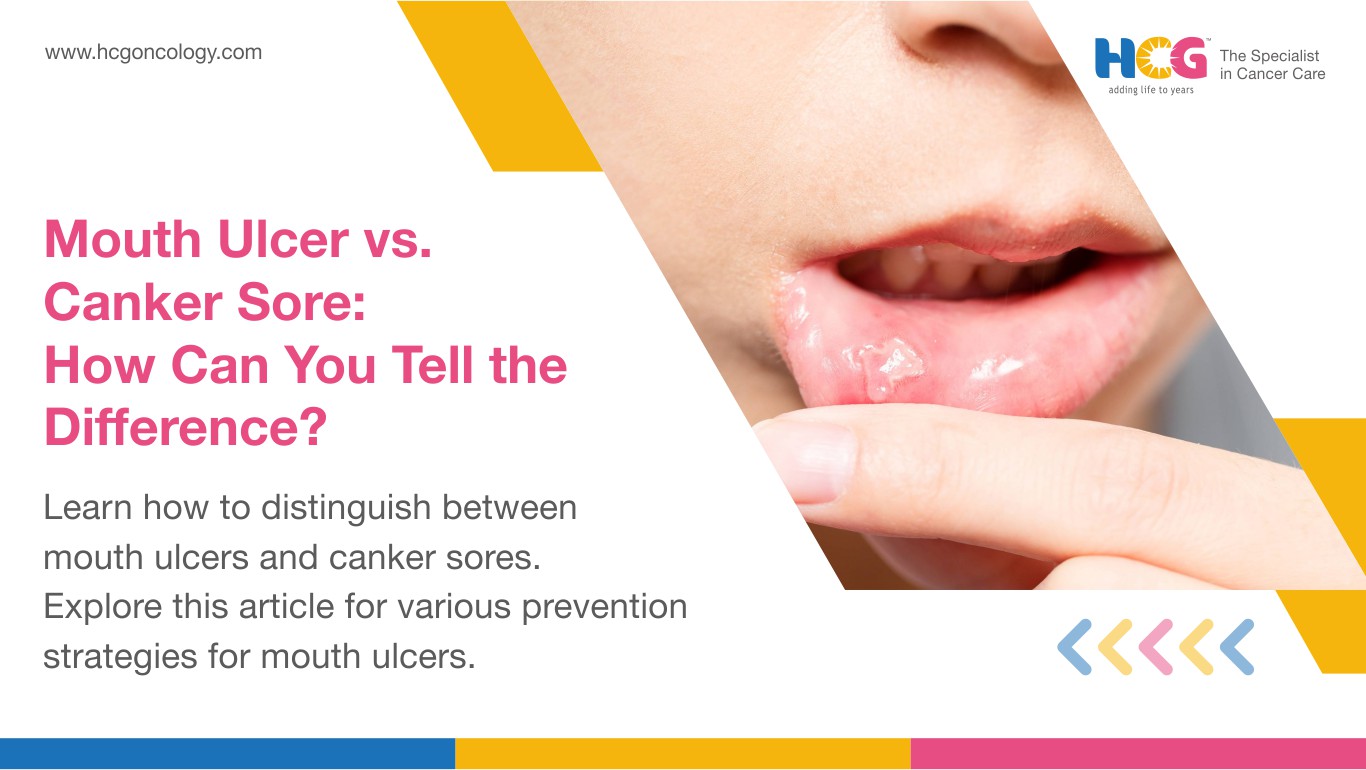
01 Nov, 2025
Feel free to reach out to us.

01 Nov, 2025

This article is medically reviewed by Dr. Satya Srinivas Appala, Consultant - Medical Oncology, HCG Cancer Centre, Vijayawada.
Mouth ulcers are sores that appear inside the mouth, often on the tongue, inner cheeks, and lips. It looks like a shallow sore with a white/grey top and a red rim.
Most mouth ulcers are small (less than 5 mm). In some cases, individuals can develop larger mouth ulcers. They can occur as a single ulcer or in a cluster.
Common causes of mouth ulcers include injury to the mouth, stress, hormonal changes, certain acidic or spicy foods, and vitamin deficiencies, particularly in B12, iron, or folate.
Canker sores, also known as aphthous ulcers, are small, painful lesions that develop on the soft tissues inside the mouth, such as the inner cheeks, lips, tongue, or gums.
Canker sores are generally round or oval in shape and look white or yellowish in the center, surrounded by a red border.
Although the exact cause of canker sores is unknown, they are often linked with factors like minor injuries to the mouth, stress, hormonal changes, certain foods (especially acidic or spicy), and nutritional deficiencies, particularly in vitamin B12, iron, or folic acid.
The terms “canker sore” and “mouth ulcer” are often used interchangeably but are not precisely the same.
Mouth ulcer is a broader term that can refer to a variety of sores in the mouth, including canker sores.
Canker sores are generally small, painful sores that appear inside the mouth, specifically on the soft tissues like the inner cheeks, tongue, or gums.
The difference between mouth ulcers and canker sores is primarily in their types, causes, and characteristics.
| Parameters | Mouth Ulcers | Canker Sores |
|---|---|---|
| Definition | Refers to any type of painful sore inside the mouth | Refers to a specific type of mouth ulcer (aphthous ulcers) that is yellow or white with a red border |
| Location | Anywhere inside the mouth | Typically, on the soft tissues inside the mouth, including inner cheeks, lips, tongue, and soft palate |
| Symptoms | Swelling around the ulcer, tingling or burning sensation, and pain | Similar symptoms |
| Causes | It could be caused due to various reasons, including infections, allergic reactions, cancer, etc. | Causes are idiopathic; they are often triggered by stress, certain foods, and dental trauma. |
| Healing Duration | The healing of mouth ulcers depends on their cause | Canker sores heal in 8-10 days |
| Contagiousness | Mouth ulcers caused due to viral infections (herpes, for example) can be contagious | Not contagious |
The canker sore and mouth ulcer differences can often create confusion, as both refer to painful sores inside the mouth. Simply put, all canker sores are mouth ulcers; however, not all mouth ulcers are canker sores.
The causes of mouth ulcers vs. canker sores are quite similar, but mouth ulcers typically have a wide range of triggers like infections and trauma, while canker sores are more commonly triggered by stress, hormonal changes, and nutritional deficiencies.
Common causes of mouth ulcers include:
Causes of canker sores:
Treatment approaches for both canker sores and mouth ulcers are similar. Generally, the canker sore heals within 1-2 weeks, but some mouth ulcers need treatment. Treatment of mouth ulcers and canker sores includes:
In most cases, canker sores and mouth ulcers are generally not symptoms of oral cancer. They are usually caused by stress, trauma, infections, or nutritional deficiencies and typically heal within 1-2 weeks.
However, sometimes unusually large sores that do not heal after 2-3 weeks or sores with raised, irregular borders, bleeding, or lumps may be a cause for concern, as they may indicate the presence of oral cancer.
Watch this video to find out how to look for the signs of oral cancer:
Yes, mouth ulcers and canker sores can be prevented through appropriate lifestyle and dietary modifications. Prevention methods for mouth ulcers and canker sores include:
Among children, mouth ulcers can cause severe pain and discomfort. However, there are many ways you can manage mouth ulcers in children:

Understanding the dynamics of canker sores vs. ulcers is essential for them to be effectively managed. If the mouth ulcer does not heal within 2-3 weeks, grows in size, and causes severe pain, you should consult a doctor. Frequent oral ulcers vs. canker sores indicate a nutritional deficiency or immune system issue, requiring medical attention.
In conclusion, understanding the dynamics of canker sore vs. mouth ulcer is crucial to identifying symptoms and seeking timely medical attention.
The answer to the question “What is the difference between a mouth ulcer and a canker sore? ” lies in their types, causes, and characteristics.
Mouth ulcers can be caused by a variety of factors like trauma, infections, or underlying medical conditions, while canker sores are more commonly linked to stress, hormonal changes, or deficiencies in nutrients like vitamin B12, iron, or folic acid.
The symptoms of mouth ulcers and canker sores are almost similar, and it's confusing to recognize the difference between ulcers and canker sores. Mouth ulcers and canker sores usually heal within 2-3 weeks, and if they don’t, you should consult a doctor.

Dr. Satya Srinivas Appala
Consultant - Medical Oncology
MBBS, MD (General Medicine), DNB (Medical Oncology)
Dr. Satya Srinivas Appala is an accomplished medical oncologist with over a decade of experience in treating and managing different types of cancer using systemic therapies. He is available for consultations at HCG Cancer Centre, a leading cancer hospital in Vijayawada. He is also well-versed in performing both autologous and allogeneic bone marrow transplants for various hematological conditions.
Appointment Link: Book an appointment with Dr. Satya Srinivas Appala.